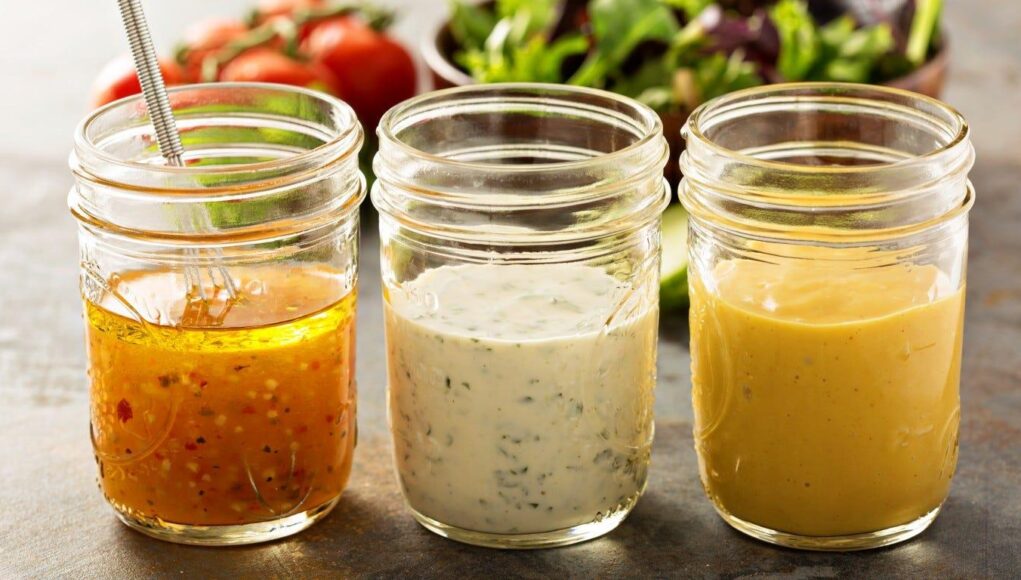America’s favorite salad dressing is ranch, according to a 2019 survey from the Food Channel. Steve Henson created ranch dressing in 1949 to feed his crew while working a plumbing job in Alaska. Henson’s blend of buttermilk, herbs and spices was a hit among his Hidden Valley Ranch guests and he began selling them in packets by mail order.
While ranch dressing is the clear winner, Caesar, buttermilk, elderberry vinaigrette and bleu cheese dressing also make appearances in the top five.
Are you a salad dressing fanatic? Here’s everything you need to know about its impact on your health.
What is the healthiest salad dressing?
The healthiest salad dressing, according to licensed dietitian nutritionist Abra Pappa, is the one you make yourself. With salad dressing, the most important thing is the ingredients used in it.
A simple and delicious salad dressing can be made with three ingredients – oil, seasonings and acid. In order to get the most health benefits, Pappa recommends looking for high-quality oil like extra virgin olive oil or avocado oil. These unrefined oils have favorable monounsaturated and polyunsaturated fat profiles, which are considered “healthy” fats.
Shelf-stable salad dressings may contain added sugar and stabilizing additives that can be avoided in homemade dressing.
“There’s a lot of manipulation of food-like ingredients that I don’t think is fair,” Pappa says. “It sets us up to fail because it’s hitting our taste perception of sugar, salt, fat in a way that becomes almost addictive.”
But is salad dressing healthy? Some say its unhealthiness outweighs any health benefits the salad itself could offer.
This is untrue and a harmful mindset perpetuated by diet culture, Pappa says. In fact, the best way to absorb the fat-soluble vitamins in greens like Vitamin K is to pair them with a fat, like an oil-based salad dressing or avocadoes. Salads are a healthy addition to your meal or daily diet, but we won’t eat them if they don’t taste good.
“It’s not delicious to have dry greens,” Pappa says. “We have to think about how we’re going to make food delicious so we could then create a habit around it that’s enjoyable.”
Love Ranch?:Hidden Valley’s new ice cream could be your new… sweet treat?
What is the healthiest oil?:Most have some benefits but these two might be best
Is creamy salad dressing healthy?
Creamy salad dressing is often seen as the biggest culprit for unhealthiness, but Pappa says there’s nothing to fear. Many shelf-stable creamy salad dressings rely on preservatives to make them last longer, so the healthiest fix is to blend some sour cream, mayo or Greek yogurt with spices to make your own.
Regardless, a bit of creamy dressing isn’t going to hurt and that little bit can go a long way.
“Creamy dressing doesn’t have to be demonized either, there are some salads that beg for creamy dressing,” Pappa says. “Is it adding back some fat and calories? Yes. Does that mean that maybe we’re balancing some other things out in the salad to accommodate that? Yes.”
How much salad dressing should I put on my salad?
Moderation is key when it comes to health, and Pappa says portion control with salad dressing comes down to preference and trial and error – start with a small amount of dressing, toss it in your greens and give it a taste.
“I think that’s one of the traps we sometimes fall into is that we think we need more (dressing) because we think lettuce doesn’t have any flavor,” Pappa says. “From a culinary perspective, we’re looking for balance. A salad, inherently, should be a bit of a palette cleanser.”
Just Curious?:We’re here to answer your everyday questions
High in iron:Add these healthy, iron-rich options to add to your diet
How to make your own salad dressing
Growing up, Pappa’s family made salad dressing using an “in the bowl” method that she recommends anyone pick up and add to their kitchen routine.
- Start with oil: Pick a high-quality, preferably unrefined oil like olive oil or avocado oil. Pour the oil in the bottom of an empty salad bowl. For two people, Pappa recommends about two to three tablespoons.
- Season your greens: Add some unique flavor to your oil – start with your basic salt and pepper but experiment with dried garlic, onion powder, oregano, red pepper flakes or even thyme.
- Toss: Add your greens and toss, making sure the leaves are coated evenly in the oil and spices.
- Add acid: Pick an acid to give your dressing some punch – this could be lemon or lime juice, red wine vinegar, balsamic vinegar or any other acid. Pappa recommends a ratio of two parts oil to one part acid but cautions you to add a little and taste test to fit to your preferences. Toss again to combine.
From here, you can customize to your heart’s content. Try adding a little Dijon mustard, honey, flavored oils, lime juice, peanut butter or even grated parmesan cheese to switch up the profile.
“Making salad dressing is so forgiving because you can add and subtract as much as you need until you get that flavor that you’re looking for,” she says.
Discover more health tips for your daily diet:
- Healthiest bread:One is best, but your options for a healthy diet are aplenty
- Healthiest fast food:This is the kind of menu you should be on the lookout for
- Healthiest nut:Add these two daily for cognitive benefits and more
- Healthiest rice:Settling the white rice vs. brown rice debate
- Healthiest oil:Most have some benefits but these two might be best
- Healthiest fruit:This one is high in antioxidants and has cognitive and cardiovascular benefits
- Healthiest vegetable:Check out these great nutrient-dense options
- Healthiest beer: Consider these factors before you crack open a cold one
- Healthiest cereal: What you need to know about the nutritional info on the back of the box








